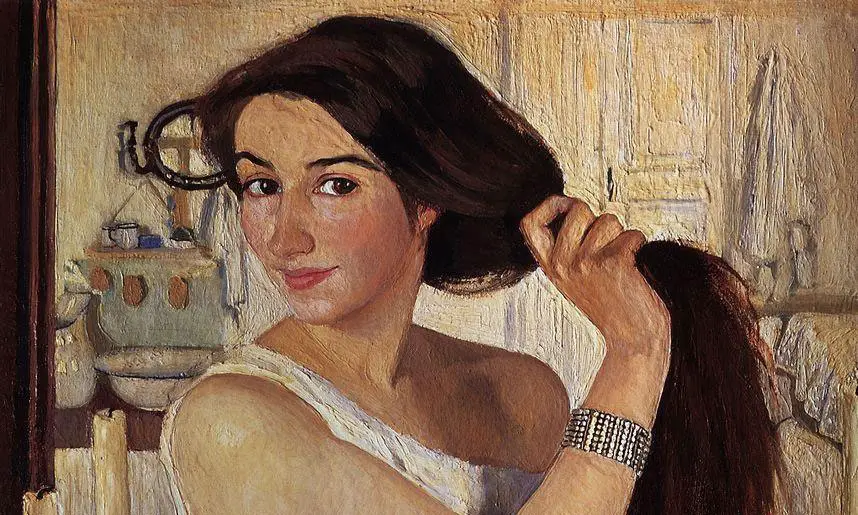“Happiness on canvas” is a phrase that well describes the early works of Zinaida Serebriakova. Best known for her vibrant, joyful style, it’s only natural that the her largest exhibit of the last 30 years, timed at the 50th anniversary of the artist’s death and the 100th anniversary of the October Revolution, coincided with spring in Moscow.
The Early Life of Zinaida Serebriakova
Zinaida Yevgenyevna Serebriakova was born on the Neskuchnoye estate in modern-day Kharkov, Ukraine, into the Benois-Lanceray dynasty of artists. The Benois family fled the French Revolution for St. Petersburg in 1794, among the last years of Catherine the Great’s reign. They were likely drawn from the chaos of the revolution by tales of Catherine’s patronage of the arts and sciences, which in particular transformed Russia’s “Window on the West,” into a city that completely integrated creatives and intellectuals into the socio-political landscape.

By the time of Serebriakova’s birth in 1884, Serebriakova’s maternal uncle, Alexandre Benois, was considered an influential Russian artist and founding member of the revolutionary Mir Iskusstva art group. Her mother, Yekaterina, was a gifted sketch artist, and her father, Yevgeny Lanceray, was a renowned sculptor. She was the youngest of six children.
In 1886, when Serebriakova was barely two years old, her father died of tuberculosis. The family moved from Neskuchnoye to the apartment of her maternal grandfather, Nikolas Benois, an imperial Russian architect in St. Petersburg. She entered the Kolumna Girls’ Gymnasium for academics, but here creativity flourished mostly at home. Her grandfather’s apartment neighbored the famous Mariinsky Theater and Serebriakova learned music and performance from her family and their social circle.
Serebriakova continued to spend her childhood summers at Neskuchnoye. The Neskuchnoye (literally: “not boring”) estate boasted endless forests, fields, and meadows that would inspire her early work. The art produced here was an ode to daily rituals and hardworking women, both enchanting and powerful in their simplicity.
The Education of Zinaida Serebriakova
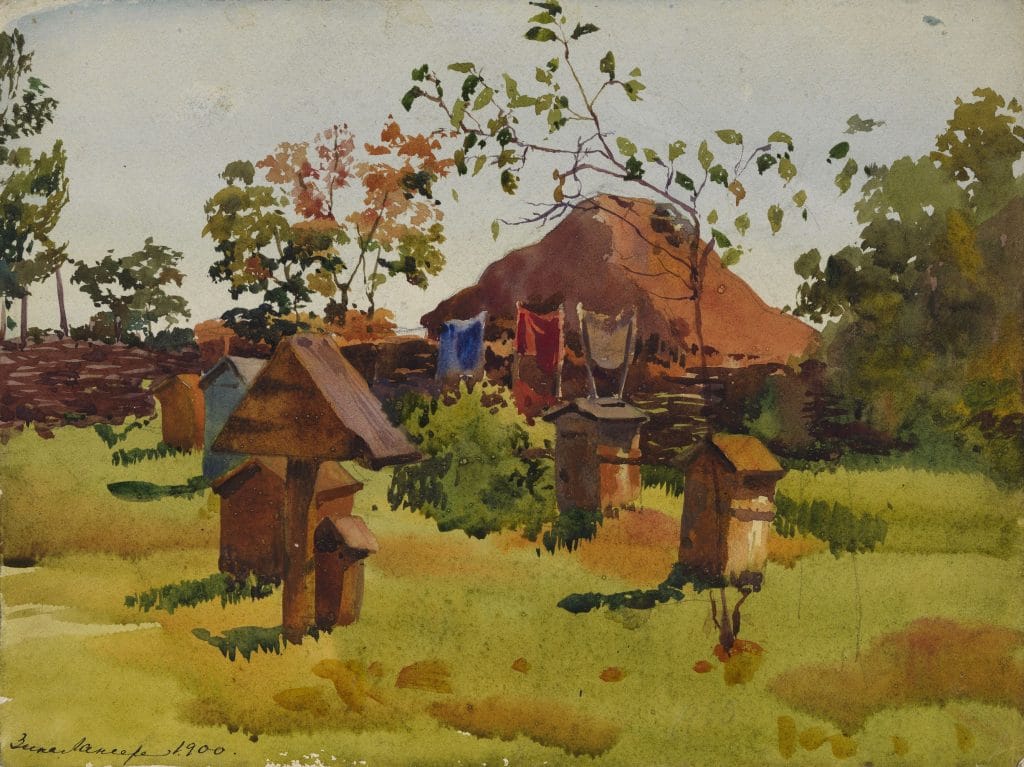
Zinaida Serebriakova graduated from Kolumna in 1900 and enrolled in Princess Tenisheva’s private art school where she met Ilya Repin, one of the most renowned 19th century realist painters. He became one of her early mentors. Her studies were soon interrupted, however, when he mother felt that Serebriakova’s health was suffering. The family went on an eight-month trip to Capri and Rome as her mother thought a winter abroad in a warmer, dryer climate would help the young artist regain her strength. Serebriakova sketched watercolor mountains and seascapes, narrow streets, and hotel interiors as she recuperated, all the while exploring Rome’s cityscapes and catacombs and enjoying the works of Tintoretto, Poussin, and Rubens.
Upon their return to St. Petersburg in 1903, Serebriakova entered the studio of Osip Braz, a Russian realist painter, friend of the family, and fellow Mir Iskusstva member. She studied under Braz for two years and, although he rarely appeared in the studio himself, his instruction left a strong imprint on Serebriakova. He charged the students with copying portraits from the masters shown in St. Petersburg’s Hermitage, which boasts the largest collection of paintings in the world, and taught the students to explore their subject’s richness and subtlety of color. In the studio, Braz encouraged pupils to work closely with nature and often employed a nude model
Summers continued in Neskuchnoye, and with each passing month Serebriakova’s mastery of landscapes, portraits, and scenes of peasant life improved. By the time she was 21, her works were rich in emotion and love for the world around her, which she found everywhere: in a peasant girl toiling under the sun, in an orchard, or opposite the river Muromki, nestled among the rolling hills and meadows, and in Boris Serebriakov, her cousin and future husband.
Boris studied at the Institute of Communications in St. Petersburg to become a railway engineer and spent his summers alongside Zenaida at the family estate. The couple sought to marry in 1905. Her family didn’t disapprove, despite the familial connections, but it was difficult to find an Orthodox priest willing to perform the wedding. A priest finally agreed for a generous fee of 300 rubles (about $6,000 in today’s money), and the wedding took place on September 9, 1905.
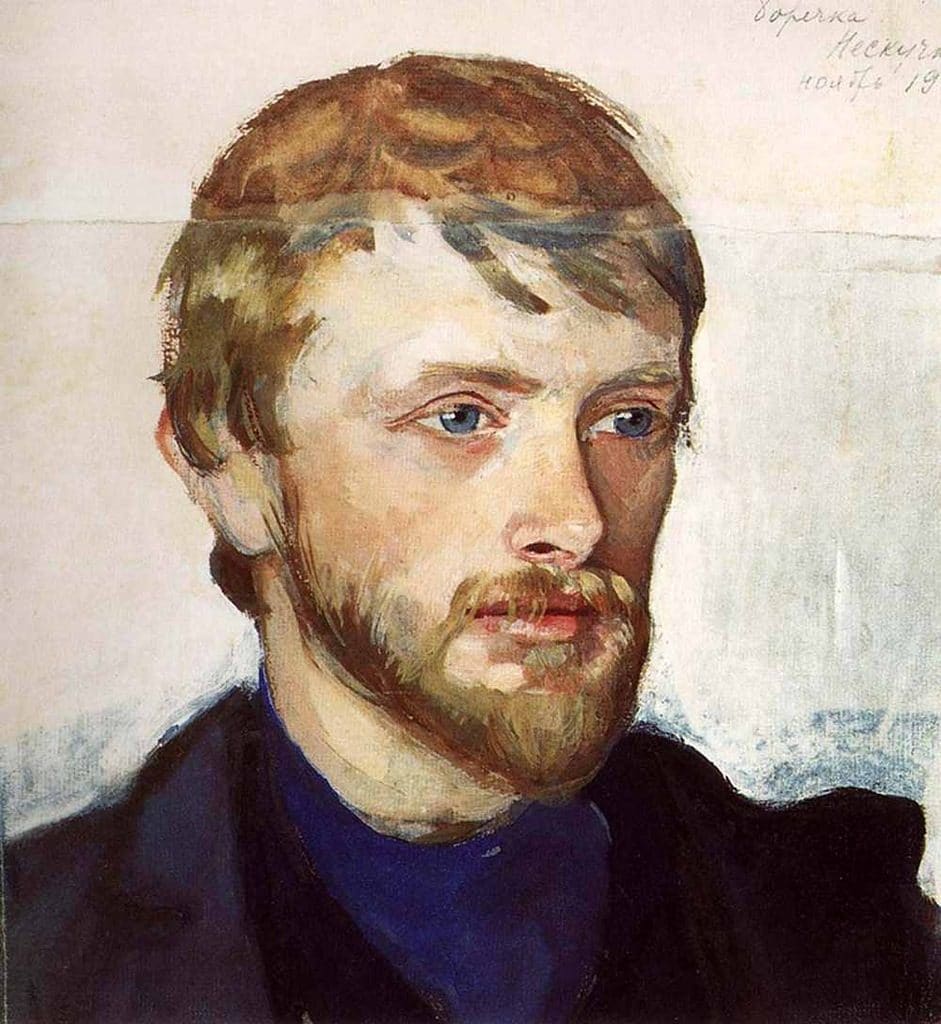
While the Serebriakovs enjoyed their time on Neskuchnoye insulated and happy, a wave of massive unrest had spread throughout imperial Russia. By mid-October 1905, over 2 million workers were on strike and very few of Russia’s railways remained active. Zinaida and her mother finally left for Paris in the beginning of November 1905, and Boris followed a few weeks later.
The Professional Life of Zinaida Serebriakova
Serebriakova was initially excited for the move, as she had hoped to continue her training in Paris alongside her uncle Alexandre Benois. While in Paris, she and her mother studied at the Academie de la Grande Chaumiere, and Boris enrolled in the Higher School of Roads and Bridges. Zinaida, however, was disappointed to find modern art in such vogue in Paris. She detested abstraction, so she resigned herself to advancing her watercolor and graphic artistry. Outside the classroom, she found inspiration in the Louvre and Luxembourg Palace and resumed copying from the masters: Monet, Delacroix, and Dega.
In the beginning of April 1906, Zinaida, her mother, and her husband returned to St. Petersburg. Zinaida’s first child, Yevgeny, was born one month later and the artist entered the happiest decade of her life. The couple’s second son, Alexander, was born in 1907, and Neskuchnoye became their primary residence again.
Serebriakova spent her free moments drawing. She was inclined to produce portraits of peasant women and children: fascinated by their bright clothing and strength of spirit. She produced some of her first broadly-respected works such as Country Girl (1906), Portrait of a Nurse (1907), and A Peasant Girl (1905).
Her landscapes, too, received special attention. Green Autumn (1908), Neskuchnoye. Plowing (1908) and Orchard in Bloom (1908) all point towards Serebriakova’s love of the land and country life.
Winter came early in 1909. Zinaida stayed at Neskuchnoye with the children while Boris left on business. One morning, she began drawing herself as seen in the mirror. The resulting portrait, At the Dressing Table, is spontaneous, compositionally simple, and intimate. She entered the work, along with 12 others, in the 1910 Mir Iskusstva exhibit of Contemporary Russian Women’s Portraits. It was an immediate sensation among St. Petersburg art critics and the Tretyakov, one of Russia’s most distinguished depositories of fine art, purchased the portrait along with Green Autumn and Peasant Woman. The self-portrait remains one of her best-known works.

Serebriakova spent the years leading up to the October Revolution travelling between St. Petersburg, Neskuchnoye, Crimea, and Moscow. Her daughters Tatiana and Ekaterina were born in 1912 and 1913, respectively, and she entered countless paintings in exhibitions across Russia. She paid special attention to females and their work. For more complicated pieces, such as her bath studies, Serebriakova would ask the same model to pose for multiple positions on the canvas.
In 1915, Serebriakova accompanied her uncle to finish a mural commissioned for the halls of the Kazansky Railway Station in Moscow, creating female nudes allegorically depicting Turkey, India, Japan, and Siam. She returned to Neskuchnoye to produce some of her finest pieces: Sleeping Peasant (1917) and Bleaching Cloth (1917), rhythmic and harmonious yet stately and calm–the type of encapsulation only obtained through careful observation, and tenderness without undue affection.
St. Petersburg’s prestigious Academy of Arts nominated Serebriakova for membership in 1917, but civil war interrupted a formal vote. She didn’t return to St. Petersburg for fear of political unrest, opting instead to rent an unheated three-room apartment in nearby Kharkiv. Here, she found work sketching artifacts, dig sites, and staff portraits for the Kharkiv University’s Archaeological Museum.
Hardships, Revolution, and Life Abroad
1919 ended a happy decade for Zinaida Serebriakova. Then 35 years old, her husband was arrested in Moscow during the Red Terror and died of typhus while incarcerated. Her anguish amplified later that year when her beloved Neskuchnoye was looted and burned. Widowed, with four small children and an ageing mother, Serebriakova returned to her childhood home in St. Petersburg. It was at this point that she produced her most somber work, House of Cards (1920), featuring her four children playing a game that brings no joy.
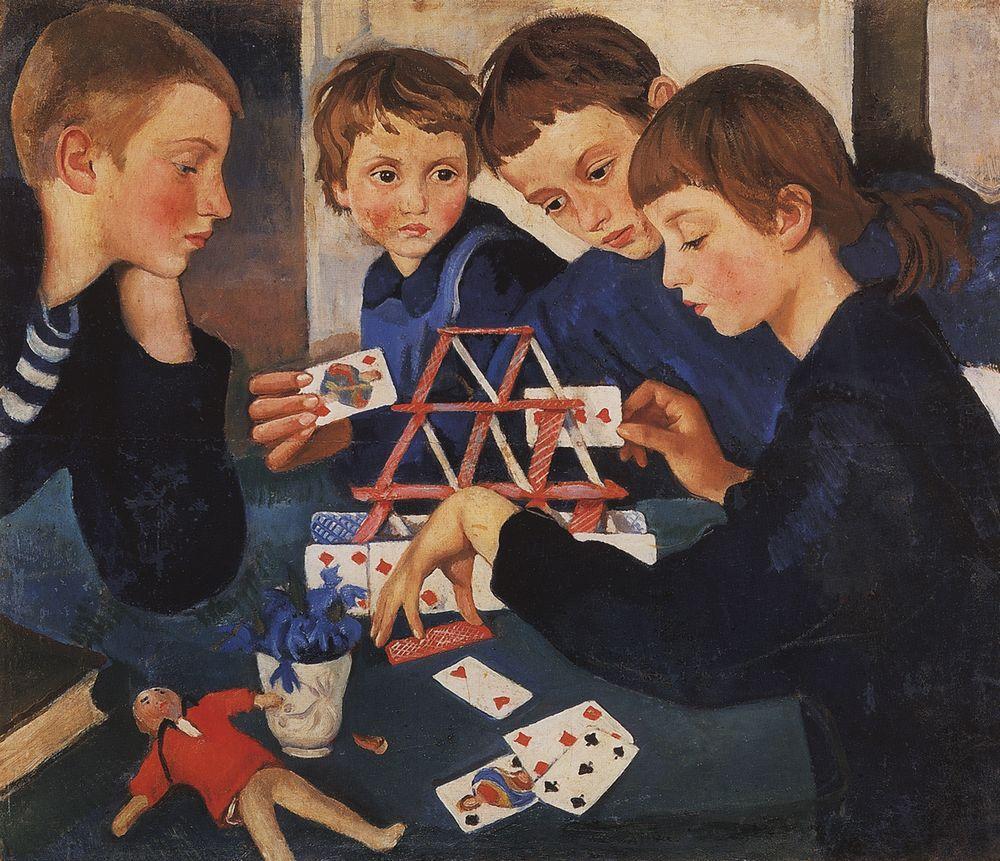
After the October Revolution, residents of private apartments were compelled to share spaces with additional people. Her grandfather now housed members of the Moscow Art Theater, and much of her work focused on theatrical life. When her eldest daughter, Tatiana, entered ballet school, Serebriakova began a series of pastel portraits of the Mariinsky Theater’s dancers. Post-revolutionary Russia rejected Serebriakova’s tenderness and, although she was financially constrained to the point that she couldn’t afford oil pigments, Serebriakova refused to paint propaganda posters.
In December 1923, Serebriakova sent 14 paintings to a travelling North American exhibition. Two of the paintings sold and Zinaida used the money to travel to France. Despite the French infatuation with modern art, Serebriakova hoped Paris would bring more portrait commissions she could use to support her family.
This decision, though seemingly prudent, proved tragic. Serebriakova left the USSR on August 24, 1924, just before the government tightened travel restrictions. When she tried to reenter, she was refused. She managed to send money back to her mother and four children, and continued working abroad and sending nearly everything she made home. Serebriakova considered her work from this period inferior, but still received critical acclaim while abroad–the French press considered her among the greatest Russian artists of the era.
In 1926, the Soviet government permitted her youngest son, Alexander, to join the artist in Paris, and Catherine followed in 1928. Despite her own artistic talent, Katya dedicated her life to serving and preserving her mother’s talent, posing whenever the painting called for a model, and cooking and cleaning while her mother painted. Alexander sketched views of Paris, illustrations for books and magazines, and maps of Paris for tourists.
Over the next few years, life improved and Serebriakova and her children took their summers in London, Berlin, and Versailles, painting custom portraits and landscapes. True to her love of peasants and their work, she considered her best pieces those of Breton fishermen. Still, Serebriakova longed for her homeland and the rest of her family.
In 1928, Serebriakova participated in the Old and New Russian Art Retrospective in Brussels and came to the acquaintanceship of Belgian aristocrat and industrialist Baron Jean de Brouwer. He commissioned the artist to produce two sets of four decorative panels for his country home: the first, reclining nudes representing the seasons, the second, upright nudes representing justice, nature, art, and light.
The Baron was so impressed with her talent that he sponsored Serebriakova on a six-week trip to Morocco in December 1928. She produced more than 130 portraits and cityscapes which she modestly called “sketches,” drawn in haste as none of the locals would agree to pose, and only three landscapes for fear of straying too far from Marrakech. Serebriakova returned to Marrakech in 1932, again under the Baron’s patronage, but left disheartened: the second trip brought nothing but rain.
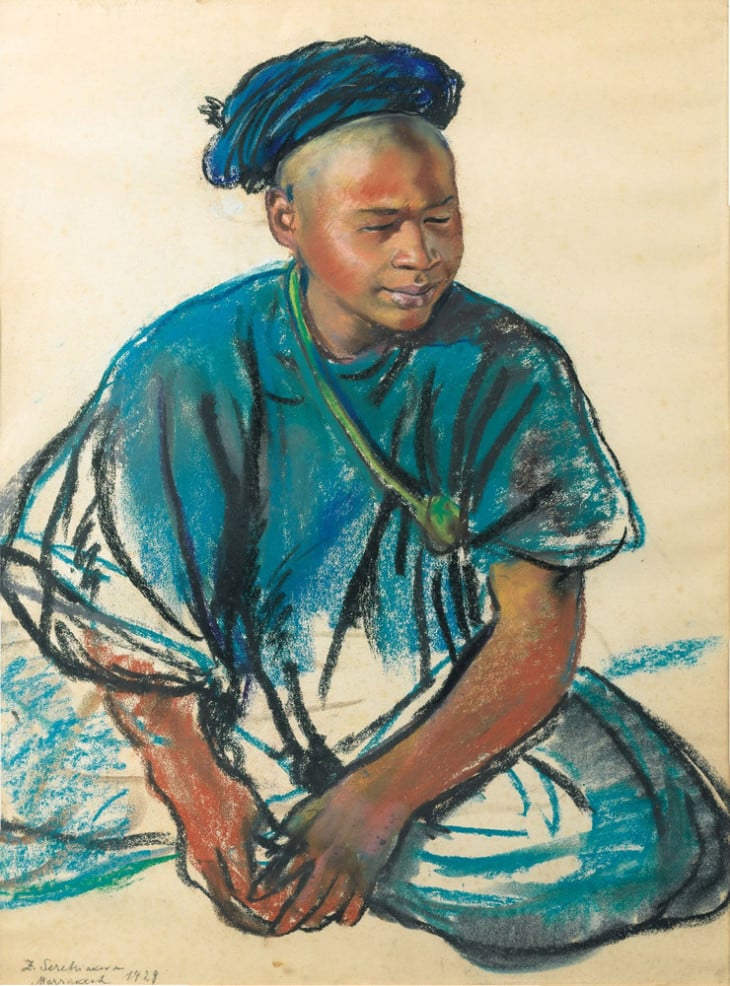
Now approaching 50, Zinaida Serebriakova returned to Paris with renewed enthusiasm. Food remained scarce, but she found a reliable customer base of Russian emigres in Paris and the French countryside, Switzerland, England, and Belgium. She worked largely with pastels owing to their affordability and ease–unlike oil paints, the canvases could be used untreated and her subjects didn’t have to sit for long periods of time. Serebriakova participated in solo and group exhibitions throughout Europe to much critical acclaim.
Portrait commissions declined as World War II engulfed the entire Western world. Although Serebriakova had maintained close correspondence with her children and relatives while abroad, communication ceased with the 1940 German occupation of Paris and subsequent Siege of Leningrad. During the occupation, Nazi leadership threatened Serebriakova with concentration camps for her communications with the Soviet Union, so she renounced her citizenship and, along with it, hopes of reuniting her family. Serebriakova was required to stay in Paris and adhere to a strict curfew, but still managed to eke out a meager subsistence with the occasional commission.
The war ended when Allied powers liberated Paris in 1942, but relief didn’t come until correspondence resumed with her eldest daughter, Tatiana, in 1946. One year later, she received French citizenship. Though in poor health, the artist resumed her travels abroad, spending her summers painting throughout England, Switzerland, and Portugal.
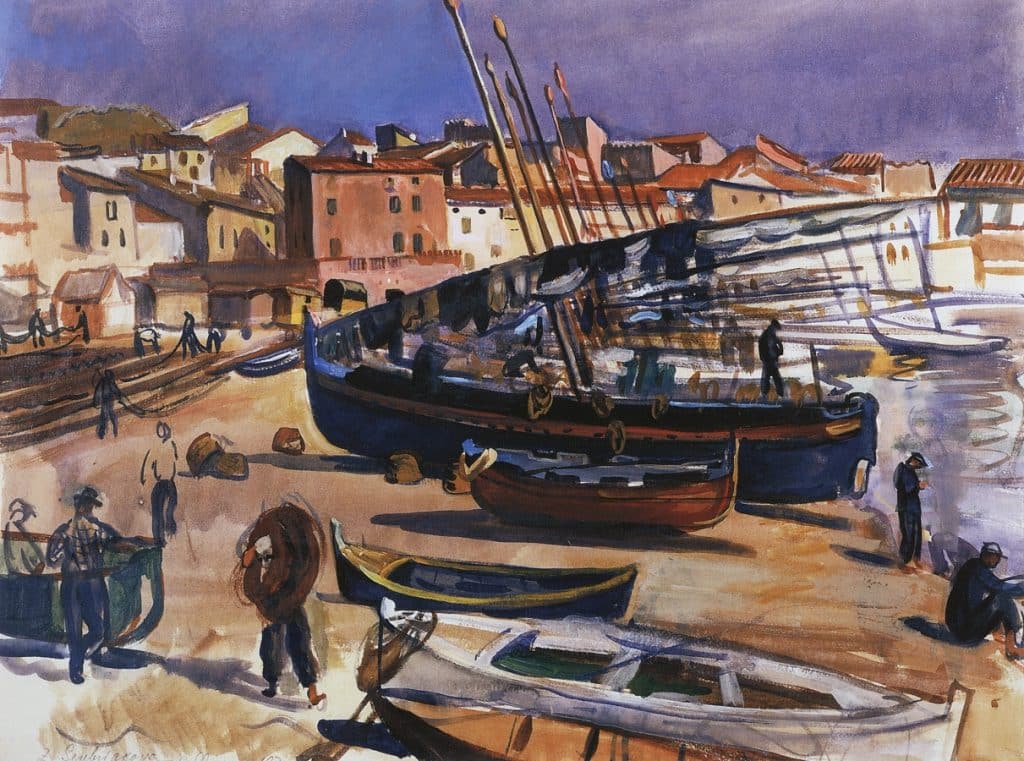
Zinaida Serebriakova Returns to the USSR
Finally, Khrushchev’s Thaw came after Stalin’s death in 1953. Although her work was on permanent display in Moscow’s Tretyakov Gallery and the Russian Museum, the Soviet government repressed Serebriakova’s name after she emigrated to Paris. During the Thaw, she was recognized for her solidarity with the masses, and by mid-April 1960, Tatiana received permission to visit her mother in Paris. Mother and daughter, now 74 and 48, respectively, reunited for the first time in 36 years.
Tatiana helped her mother organize a retrospective in Moscow. She returned to Paris in 1964, this time to help select works for the exhibition, which was to open in 1965. Although Serebriakova was concerned her pastel portraits would be damaged or lost during transit, more than 250 of them ventured to the Soviet Union with Tatiana.
Zinaida Serebriakova arrived to Moscow in May 1965, her first time on Russian soil since her involuntary emigration. The exhibition opened first in Moscow, then moved to Leningrad and Kiev. The works were unlike anything their audience had seen before, and received rave reviews. Serebriakova rejoiced at success in her homeland. Tatiana and Yevgeny visited their mother in Paris once more in 1967. She died after a brain hemorrhage on September 19, and was buried at the Russian cemetery in the Parisian suburb, Sainte-Genevieve-des-Bois.
Despite the craze for French impressionism, cubism, and later, Socialist realism, Zinaida Serebriakova stayed true to the Russian pre-revolutionary realist tradition. Her early works are now considered among the most careful and accurate representations of the imperial Russian countryside, lauded for their attention to the temperament of both people and land. Serebriakova’s dedication to anatomical truth leads to unexpected, fluid movements that highlight the plasticity of the human body and autobiographical encapsulations in her portraits. Her works are not intended as photographs, but Serebriakova’s manifestation of beauty.



